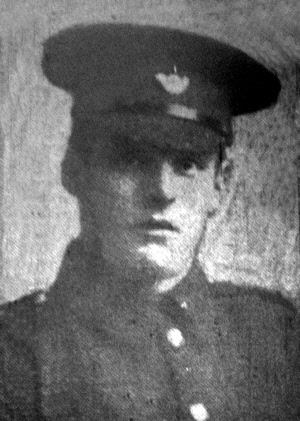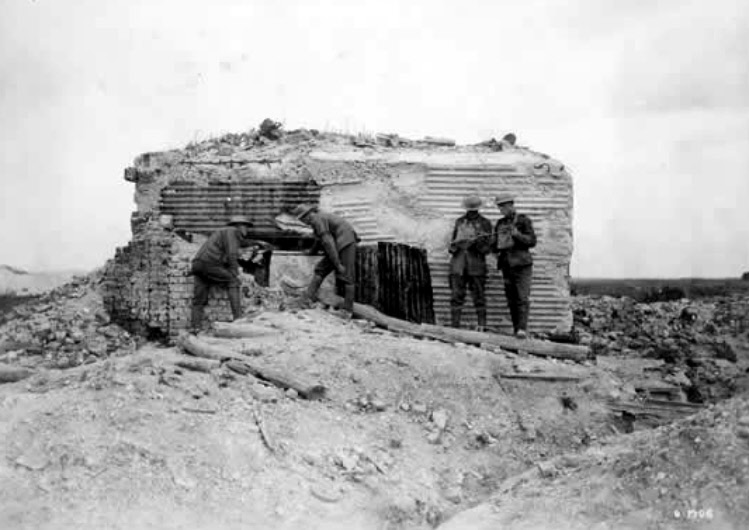
George Arthur Deighton was born on the 21st February 1896 in Leeds and he was baptised on the 7th September 1897 at Dewsbury St Mark’s Church. His parents, George and Mary Ann (nee Hackett) had married in the Worksop registration district in 1884. They were living at 61, Victoria Road, Dewsbury and George was working as a coachman. At the same Church, eight days later, on the 15th September 1897 George and Mary Ann’s children, May (b. 1887) Harold (b. 1889), Beatrice (b. 1891) and Florence (b. 1893) were also baptised.
In 1901, the family are living at 22, Woodbine Street, Dewsbury and George’s father, also George, is working as a domestic coachman. There are seven children, four girls and three boys in the household; a male boarder and also a female visitor. The house has five rooms.
In 1911, George, now aged 15 and working as a groom is living with his Lancashire born parents George and Mary Ann Deighton at 2, Victoria Street, South Ossett. The couple have been married for 26 years and have had eight children, all of whom have survived to 1911. Seven of the children: three girls and four boys, aged 7 to 23, are living in the household. George’s father is a coachman for a cloth manufacturer and his mother is working as a dressmaker. Only the youngest child, aged 7, was born in Ossett with each of the others born elsewhere, an indication that the Deighton family had been very mobile whilst George was growing up.
The 2nd Battalion of KOYLI was a regular army battalion and at the start of WW1, in August 1914, was based in Dublin as part of 13th Brigade in the 5th Division. On the 16th August 1914, they landed at Le Havre and then on the 28th December 1915 they transferred to 97th Infantry Brigade, 32nd Division. George Deighton joined the army in late 1916 and would have transferred to the decimated 2/KOYLI in early 1917.
The “Ossett Observer” 1 had this obituary for Private Deighton:
“Another South Ossett soldier in the person of Private George Arthur Deighton (21), son of Mr. and Mrs. George Deighton, Victoria-street, has given his life in his country’s service. The young man, who was attached to the K.O.Y.L.I., joined the army in November 1916, and has been out in France since March or April last year. He was expecting being home on leave this week. In civilian life he was employed at Ossett railway station and formerly worked at the Horbury Junction ironworks.
According to a letter received this week by his parents from an army chaplain, Private Deighton was killed in action on the night of 18th February. Along with others he was out on a raiding expedition and was caught in an enemy barrage while returning. His body was brought in and buried alongside some of his comrades.
The chaplain comments ‘We all feel deeply sorry for you and send you deep sympathy. He was such a good lad, and his pals miss him so much. It seems hard to part with these brave, dear lads. We can only hope and trust to meet them again in a better world. May God give you courage to bear your loss is the prayer of all officers and men of the K.O.Y.L.I.’
In July last year deceased received a bullet-wound in the thigh and was treated in a French hospital.”
Private Deighton was killed in action on the 18th of February 1918 during a raid on German lines somewhere on the Western Front. It is very likely that he was actually killed by walking inadvertently into an artillery barrage from British guns:
“The raid was carried out by ‘B’ and ‘D’ Companies (of 2nd Battalion KOYLI), and was of some importance. Orders had been elaborately worked out and were carefully adhered to, with the result that the raid was completely successful. The 2/Border carried out a similar raid at the same time on the right of the K.O.Y.L.I. Congratulatory telegrams were received on the result from all commands, even from the Commander-in-Chief.
The action of the assaulting companies was as follows: ‘D’ Company, the right attack, had for its objective, three pillboxes by the farmhouse, while ‘B’ Company, the left attack, was directed on a group of three posts or shelters. Each company had three platoons in the attack with separate aims in view and one platoon in support.
‘Zero’ hour was 11 p.m. on February 18th. Promptly at the hour our artillery bombardment descended on all objectives and the raiders attacked. The right platoon of the right attack (‘D’) arrived at its objective in nine minutes. The box was attacked by passing round both its flanks; the box was captured and one prisoner was taken.
The centre platoon of ‘D’ reached its box at about the same time; the defenders came out to fight; five were killed in a bayonet fight, four others were captured with their machine-gun in the building, which was entered and searched.
The left platoon of ‘D’ had advanced with the centre party as far as their objective and then went on to attack the third box. Lt. A.F. McC Riggs in command of this party, rushed up under rifle-fire, and seeing the enemy in the act of pushing a machine-gun into position at a low loophole, he kicked the gun aside and inserted a bomb into the loophole; the bomb destroyed the gun. He then led his men round the box and encountered the enemy at its entrance. Eight surrendered, but others inside the box refused to come out; a bomb was thrown in, to which the defenders replied with another, which exploded and wounded Lt. Riggs on the hand. More bombs followed and the box was taken; ten of the enemy were discovered dead inside. This company had one officer and six other ranks wounded.
In the left attack the platoons of ‘B’ company rushed the posts as soon as the barrage lifted, but they were already vacated. All platoons at once rushed forward over some wire to search the area allotted to them, eager to secure prisoners and identifications. Three further posts or shelters were discovered, guarded by a mesh of wire which had to be cut. Parties then streamed through the gaps and rushed the shelters. 2/Lt E.D. Sewell’s party on the left bombed and entered the left shelter; two dead were found and identification secured. The centre shelter proved a blank. The occupants of the right one refused to surrender and were bombed; when the place was entered, six dead were found in it. The platoons then spread out and again pushed forward, but in their eagerness to secure prisoners and beat the record of the company in the right attack, they advanced right into our barrage and suffered a few casualties.
Forty-eight minutes after ‘Zero’ the commander ordered the retirement. A directing tape had been run out for 500 yards to guide men back in the withdrawal. This proved of great value, for the stars were obscured by the smoke from our shell-fire. There were ten casualties in ‘B’ Company, of whom two other ranks were killed, six wounded and two missing.” 2

Above: A captured German pillbox near Lens, like the ones involved in the raid by 2/KOYLI on the 18th February 1918.
George Deighton’s service record has not survived. His medal records show that he was awarded the British and Victory medals and that he was killed in action and that the enlistment location was Ossett.
Private Deighton died at the age of 21 years. is buried at VI. C. 7 in the Artillery Wood Cemetery 2, Ieper, West-Vlaanderen, Belgium. Boezinge is located north of the town of Ieper on the N369 road in the direction of Diksmuide.
Until July 1917, the village of Boesinghe (now Boezinge) directly faced the German front line over the Yser canal, but at the end of that month, the Battle of Pilckem Ridge pushed the German line back and Artillery Wood, just east of the canal, was captured by the Guards Division. They began the cemetery just north of the wood when the fighting was over and it continued as a front line cemetery until March 1918. At the time of the Armistice, the cemetery contained 141 graves (of which 42 belonged to the Royal Artillery), but it was then greatly enlarged when graves were brought in from the battlefields and small burial grounds around Boesinghe,
References:
1. “Ossett Observer”, 23rd March 1918
2. “K.O.Y.L.I. in the Great War” by R.C. Bond